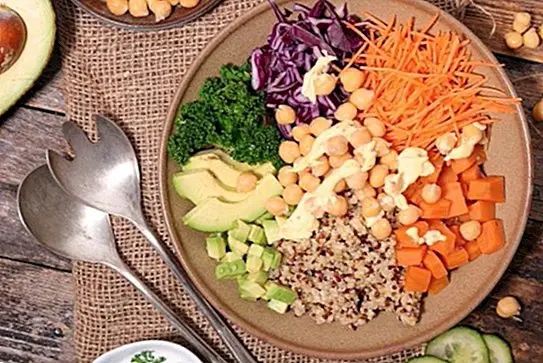What is macrobiotic cooking and what foods to include
It is quite likely that you have already heard about it at some time but, do you really know what it is? The one known as macrobiotic diet it is not just a type of diet or food, it is also a lifestyle that seeks to establish a relationship of harmony between our own interior and our surroundings.
In short, what the macrobiotic diet seeks is to make us happier, enjoying everything that surrounds us from a respectful point of view, in search of well-being and maintaining a correct eating habit.
We can say in fact that The macrobiotic diet is based on a principle: that of balance and harmony, especially taking into account that our nutritional needs are determined by our surroundings, by our geographical and climatic situation where we develop our life, by the activity that we carry out every day and by our own constitution and our health.
Therefore, when we talk about macrobiotic cuisine we must refer to the type of cooking of macrobiotic food, which takes into account all the factors indicated above when preparing food, which undoubtedly allows greater control over health, although they are not taken into account. account so strictly your calories and nutrients, as it does with other types of kitchens and diets.
To monitor the macrobiotic diet is very important have a good knowledge of food, especially from a nutritional point of view, always choosing natural foods, that have not been previously processed.
For example, a useful option is to opt for cooking that does not alter the food much, such as simply boiling them in water, or even opting directly to eat them raw. In this way, the food will provide all its essential nutrients completely.
It is also emphasized that macrobiotic cooking foods must come from biological crops, which are characterized by using only organic fertilizers, excluding chemical fertilizers, toxic fungicides and pesticides.
What foods do we find in macrobiotic cooking?
We must bear in mind that macrobiotic diet promotes a type of diet based on the consumption of natural and vegetable foods, and at the same time discourages processed foods, dairy products and meat.
However, unlike what is mistakenly thought, it is not a diet, but a kind of philosophy that gives us the possibility to understand how we relate to the environment that surrounds us, being aware of the qualities that It gives us the food we follow, and therefore, the food we consume at all times.

Thus, we can differentiate between those foods that stand out for presenting a more adequate balance in terms of their nutritional and energy intake (so they are recommended to be consumed daily), and those that we should avoid, consume occasionally or in small quantities (considered as food). ends):
- Ideal foods to include in daily macrobiotic cooking:Vegetables and seasonal fruits (depending on the fruits can be consumed cooked, macerated or raw), legumes, whole grains (oats, brown rice, millet, quinoa, rye, wheat, spelled, kamut, buckwheat and barley), seeds, fruits dry, fermented foods, algae and animal protein from fish.
- Foods to avoid, consume occasionally or in small amounts: They depend directly on whether they are food with Yang energy (meat, sausages, eggs, salt, baked or fried products, cheeses) or with Ying energy (dairy, chocolate, sugar, alcoholic beverages, fresh cheese and tropical fruits and vegetables) .
In this sense, the whole grains they have an important position, since the macrobiotic philosophy considers them as a food with a high potential to generate life, since the seed of the plant is intact. They have a high nutritional value, besides being very complete, so they are considered as the main element of the food.
The vegetables in the macrobiotic kitchen: each in its correct order
In addition to whole grains, vegetables also have a dominant position in macrobiotic cooking. In fact, in this it is common that Vegetables and vegetables are classified in order according to their energetic nature(energy understood not in its usual definition, measured in calories, but the "energy" that is supposed to transmit each food naturally by itself).
That is, they are divided into leaf or stem vegetables, vegetables that grow above the ground, and root vegetables.The former provide greenery, freshness, and are ideal for cleaning and renewing blood. We can mention spinach, watercress, celery, chard, lettuce, parsley and chives, among others.
The second ones, those that grow above the earth, usually bring calmness, center and serenity. They are broccoli, onion, pumpkin, cabbage and cauliflower. And, finally, we find the root vegetables, which stabilize us and increase the absorption of nutrients by the intestine; They are radish, ginger, beet, carrot and parsnips.

The importance of the five flavors
When it comes to cooking any dish based on the philosophy of macrobiotic cooking, it is necessary to look at the five known flavors, related to the theory of the five elements, and that helps us to better integrate the necessary food to balance our plate. food:
- Sweet taste:basic, should be the predominant. It nourishes us and calms us. They are foods like fruit, vegetables, vegetables, legumes and whole grains (as long as they are well chewed).
- Salty flavor:It brings heat, tones and activates. Highlights include salt and seaweed and other condiments such as gomasio, miso and shoyu.
- Bitter taste:purifies, activates circulation. They emphasize green leaves, endives and toasted seeds.
- Spicy taste:Tones and activates the respiratory tract, activating the functioning of the intestines. Highlights: raw onion, mustard, ginger, radish.
- Acid taste:Calm, activates the digestion of fats and therefore the function of the liver. Highlights include apple cider vinegar, rice vinegar, umeboshi vinegar, citrus and sauerkraut.
Images of Istockphoto. See bibliographic references
- Bernard Benbassat. The great macrobiotic kitchen. (2017). Integral.
- Simon G. Brown. Modern Macrobiotic. (2015). Gaia


